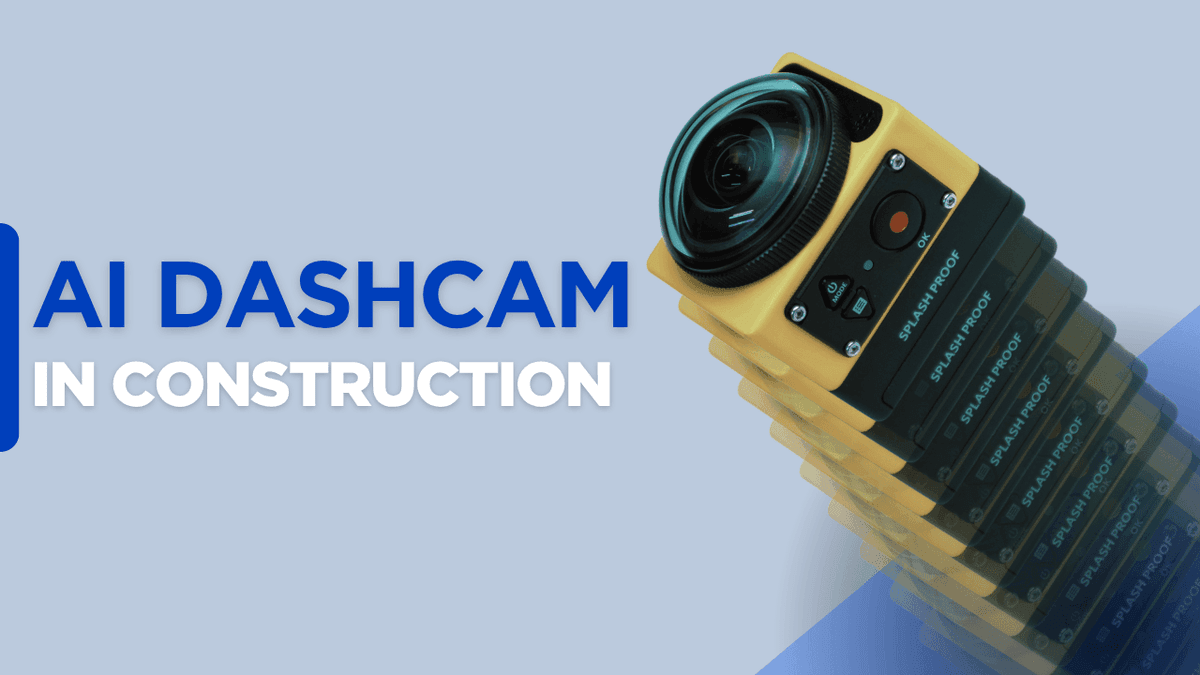Extra Pair of Eyes: How AI Dashcams Change Risk Management in Construction
Construction is dangerous job, but a newly introduced technology, AI dashcams, is here to address the high-risk nature of construction jobs.
by Sheldon Huang
|
Construction has always been a high-risk occupation from accidents like fall-from-heights, caught-in/between accidents, electrical hazards, etc.
According to the US Bureau of Labor Statistics (BLC) in “Census of Fatal Occupational Injuries News Release,” released by the BLC in December 19, 2024, construction (as an occupation) holds the second most (behind Transportation and material moving occupations) Fatal Occupation Injuries in the year 2019-2023.
From the year 2021 to 2022, fatal work injury rates (per 100,000 full-time equivalent workers) increased by 5%, while the number of fatal occupation injuries increased by 11%.
Because of the inherent risks in construction, the use of PPE (Personal Protective Equipment) has become the norm, aiming to better protect those who come in contact with these accidents.
However, the use of PPE merely lessens the damage of accidents. To achieve the prevention of jobsite accidents, some have start employing Artificial Intelligence (AI) in jobsites. More specifically, dashcams powered by AI are appearing in jobsites as an extra layer of jobsite risk management.
In the following texts, this blog will explore the applications, pros and cons, and future possibilities of AI dashcams in construction.
How Do AI Dashcams Work?
Dashcams have long been present in jobsites, operating to monitor jobsites, provide track records, and assist in risk assessment. However, AI-powered dashcams aren’t the norm in jobsites yet, so most are unfamiliar with how AI dashcams work and what it can achieve.
Incorporating AI with dashcams allows dashcams to do more than just record footage. It opens dashcams to provide more safety and/or utility through automated warnings and indicator identification.
AI allows dashcams to, through its footage, identify risk factors and common indicators of jobsite danger, and send warnings to remind workers of potential risk and to eliminate the risk if possible.
For example, as stated by Motive, a Motive AI dashcam is capable of identifying workers entering jobsite without proper PPE, and sending a notification to correct the behavior. Other examples include identifying a person standing within “unsafe proximity of heavy machinery,” or an “unauthorized entry into restricted zones.”
AI dashcams can incorporate telematic data with footages if used on a vehicle as well. Telematic data such as fuel consumption, traveling speed, and load weight are all factors that AI dashcams take into account.
Other than telematic data, driver behavior are monitored through analyzing footages as well, such as signs of fatigue, distress, or safety measures like seatbelts.
AI opens dashcams to these possibilities and allows dashcams to become more than just cameras.
What Pros and Cons Do AI Dashcams Bring?
As mentioned earlier, AI dashcam brings security to jobsites through monitoring, identifying, and correcting potential hazards and risks. However, AI dashcams bring even more benefits to people who work in the construction industry if employed properly.
Reduced risks and a safer work environment can help the construction industry maintain a high workforce retention rate. Especially with the recent labor shortage in the construction industry, this can be the difference between revitalization for the industry or downhills henceforth.
Automating tasks of monitoring safety and eliminating risks reduces the amount of time required to meet safety standards, leading to increased productivity. AI dashcams’ ability to monitor multiple areas of multiple jobsites simultaneously also leads to a more scalable business for contractors and business owners.
Some AI dashcams, with higher resolution recording, over-the-air updates, and dual-lens systems (some may even have 360-degree visibility), provide better consistency in recordings than ordinary dashcams. This significantly helps with liability and credibility issues if things get unfortunate.
With that being said, every coin has two sides: AI dashcams come with their disadvantages as well.
Even with AI dashcams, 100% complete safety is impossible. On the off chance that an error occurs, the aftermath can get significantly more severe from the false sense of security of an AI dashcam operating.
Additionally, employing AI dashcams on a wide scale can be expensive, which is especially discouraging to Small and Medium Enterprises (SMEs). The cost, mainly financial, that comes with installing AI dashcams can pose a major impeding factor towards popularizing it.
The Future of AI Dashcams
Currently, AI dashcams are yet to be popularized among the majority of the construction industry. With that said, according to a study conducted by Motive, “79% of construction leaders want to integrate generative AI into their workflows.” When AI dashcams are more widely integrated into the everyday work of construction in the future, the safety of construction workers would be better guaranteed.
On top of this, the name “construction” would stop being perceived as “dangerous” or “high-risk” by the public. The use of AI dashcams would further promote safety culture into sites and teams through systems like positive affirmation, similar to dashcams used for fleets.
Despite bringing numerous benefits, like any other product, AI dashcams are not perfect, nor will it ever be.
Optimizations and improvements made to AI dashcams in the future can bring more utility to those who work in construction. For example, integration of AI dashcams with other existing tools, such as BIM, will allow it to further assist us.
Expanding the functions of AI dashcams will allow it to automate more tasks and allow contractors and workers to focus on those truly important. In the future, we can expect construction sites to gradually grow more efficient and provide safer, more ideal working conditions.
Conclusion
AI dashcams are relatively new to construction. Some time is needed before the industry is fully adapted to working with this technology. However, there is tremendous potential hidden within AI dashcams. If utilized properly, this can be a force that changes the industry completely.
